The Journal is published by the Nature Conservation Agency of the Czech Republic in cooperation with the Cave Administration of the Czech Republic, the Krkonoše Mts. National Park Administration, the Bohemian Forest Mts. National Park Administration, the Podyjí National Park Administration and the The Bohemian Switzerland National Park Administration. It has been published since 1946.
cs / en
Nature Conservation 2020 — 25. 3. 2020 — Research, Surveys and Data Management — Print article in pdf
Monitoring of Alpine Bells in the Macocha Abyss

Alpine bells (Cortusa matthioli subsp. moravica Soják) is undoubtedly one of the most famous plants of the Moravian Karst, even though very few people have ever seen it. This is because it grows in the Macocha Abyss, high on the vertical rock walls. Access to the habitat is very difficult and only possible with the help of ropes and for physically fit people with the necessary experience. Previously, part of the Alpine bells population also occurred on the debris cone at the bottom of the Abyss, from where it was first described. However, only three specimens now survive here.
Alpine bells is a glacial relict which occurs in the Czech Republic in only one place on the northern face of the Macocha Abyss. It is a small, isolated population; the closest localities of this species are in the Strážov Mountains and Malá Fatra Mountains in Slovakia and in the Alps. The long-term existence of this montane species is possible thanks to the cold and humid climate under rocky overhangs. The site is without direct sunlight all year round, and it is under the constant influence of cold air from the caves on the Punkva River, which are located below it. The first reports of the occurrence of Alpine bells at Macocha come from the years 1918–1921, with other authors mentioning this species later. However, data on the size of the local population differ significantly. It is almost certain that the experts who were studying Alpine bells never visited all the sites high on the rock face, but only investigated the localities on the debris cone, and possibly above the upper pool, which can be seen from the floor of the abyss.
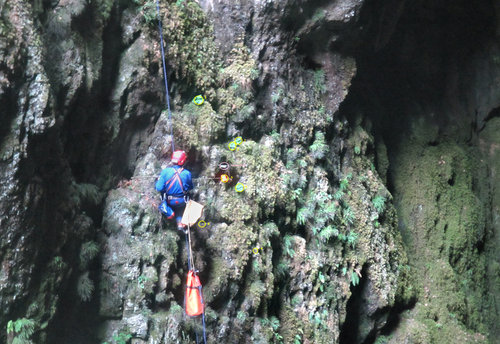
Marking Alpine bells plants with dots. Photo Karin Hustáková
Monitoring of Alpine bells was begun by staff of the Czech Nature Conservation Institute (NCA since 1995) in 1992 by counting them with a stationary telescope from the upper rim and floor of the abyss (Řičánek 1994). This method was insufficient for obtaining more detailed data because of the large distance between the observer and the sites, and the acute angle at which the plants were observed. This led to inaccuracies in the surveying and over time it was no longer possible to identify individual clumps.
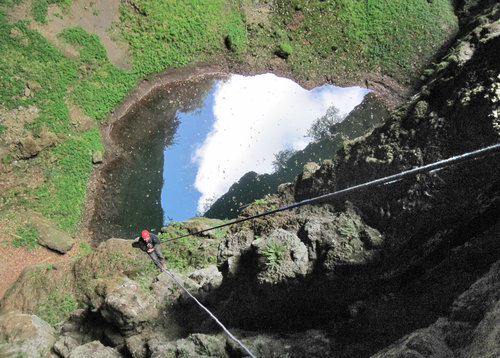
Abseiling technique during Alpine bells monitoring. Photo Bohuslav Koutecký
Further research was carried out with the participation of specialists from the Institute of Botany at the Academy of Sciences of the Czech Republic (ASCR) and other specialized institutes. Besides botanists, the former NCA branch in Brno also employed an experienced rock climber, as by combining these specializations, it was also possible for experts who would otherwise not have been able to visit the Alpine bells, to get there. Installation of the climbing route was very difficult as the rock wall is 120 m high and is rugged, with numerous overhangs and is heavily weathered. It was absolutely necessary to select the route to be as close to all localities as possible, but so that the plants could not be damaged by the climber’s movements. The route consists of 5 interconnected sections; when climbing and descending it is necessary to switch from one rope to another. Throughout the event, the climber hangs from a rope. Given the difficulty of access, it is imperative that the expert studying Alpine bells is accompanied by an experienced climber on the other rope, who in addition to auxiliary activities (photography, transport of necessary equipment, etc.), ensures the safety of the botanist on the rope. This is a life-threatening activity and without the assistance of a professional climber; a visit to this site is completely out of the question. Any mistake with handling the ropes would result in a long fall with fatal consequences.
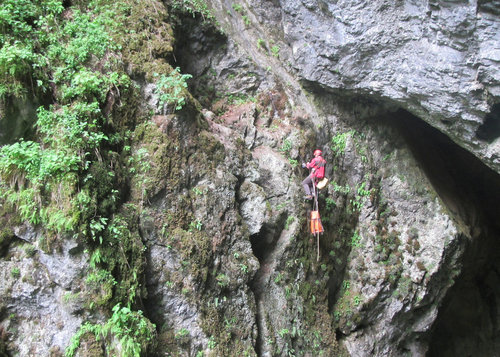
During abseiling, a careful procedure is necessary to avoid damage to the plants.
Photo Karin Hustáková
Monitoring methodology
Monitoring of Alpine bells in the years
1992–2012 was focused on visual assessment of the state of the population, and very rarely on sampling for various analyses. Seeds were collected and attempts to grow plants were made. The seeds germinated without problems, but the young Alpine bells soon died without apparent causes. In 2013, in cooperation with Palacký University in Olomouc, a detailed census was carried out, connected with the drawing of plants into photographs of the rock wall. At the same time, leaf samples were taken for the genetic laboratory. The drawings were made by a researcher standing on the floor of Macocha, based on telescope observation, and at the same time a climber who was moving slowly across the wall, using radio communication to report the position of individual plants. The number of plants was easily counted with this method, but an accurate map could not be made, as some parts of the Alpine bells habitat are not clearly visible from the bottom and distortions occurred due to the acute viewing angles. Therefore, in 2017, the monitoring method was modified so that the climber on the wall with the Alpine bells shows all plants gradually with a long orange-tipped pointer, while the other monitor (preferably a pair of climbers) descends the rope along the opposite wall of the abyss to the same height, from where he photographs the location of each plant and records the data radioed over by the first climber onto his dictaphone. At the same time, he plots everything in the background photo. After the processing of this data, a very accurate record of all individual Alpine bells was created. Each plant thus received its registration number, was plotted in a photograph of the whole group, and its fertility or sterility and other additional data were recorded. Monitoring using this method was carried out twice a year in 2017 and 2018, at first at the time of flowering (June) and then at the time of seed ripening. This map of the distribution of all Alpine bells individuals has become a quality basis for monitoring in the coming years.
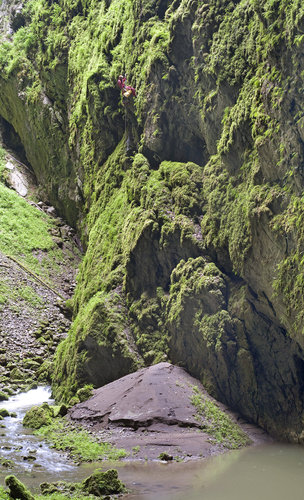
Biological survey of the wall above the upper pool.
Photo Petr Zajíček, Cave Administration
of the Czech Republic (CACR).
The disadvantage of this method is its extreme difficulty. It is a dangerous activity and neglecting even seemingly small things could easily end up tragically. The activity must therefore be led by an authorised speleological instructor, who ensures that the ropes are tied safely, and takes care of all technical and safety matters. Surveyors must be qualified to work at heights, have the necessary experience to do so, and be able to work independently in this extreme environment, where otherwise ordinary activities (photography, writing, etc.) encounter feasibility limits. Furthermore, a large amount of climbing material is required (3 complete climbing sets, approx. 400 m of climbing ropes and other aids). In spite of all these problems, however, it can be stated that this method has proved its worth and has enabled results to be obtained in a quality that would otherwise not be achievable.
Description of the Population
Alpine bells occurs only on the permanently shaded part of the northern wall of Macocha in 3 places. The first part of the population of about 14 individuals is located about 70 m above the bottom of Macocha Abyss. These are the most vital specimens of the entire local population, only here ripening seeds were found repeatedly (only 3 times in 1993–2018). A second group of about 13 plants grows on terraces on the rock wall at a height of about 30 m above the bottom. The third group (20 individuals) is located slightly below it, on an inclined rocky plate at a height of about 15 m above the bottom. This group is then followed by the last, lowest place of occurrence: the edge of the talus cone at the bottom of the abyss above the pool, where there are now 3 plants.
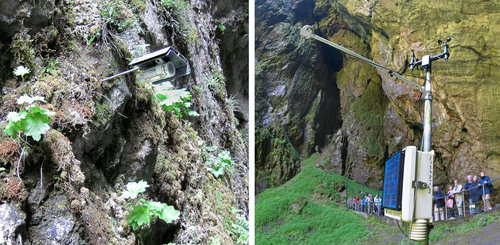
Monitoring probe on the Macocha Abyss cliff face (on the left).
Photo Bohuslav Koutecký
Former microclimate monitoring at the bottom of Macocha (on the right).
Photo Petr Zajíček, CACR
The upper group flowers first, as it has the most light and warmth of all three. It often happens that the Alpine bells has already flowered at the upper level, while the bottom groups are still in bud. The lower part of Macocha Abyss is strongly influenced by the cold and very humid air flowing from the caves, where the year-round temperature is around 8 °C. This is probably the reason why seed ripening has never been recorded at the lower localities. After flowering, the green seedheads are always attacked by mould and die.
The first report on the occurrence of Alpine bells (Podpěra 1921) states that 50 clumps were found. In further reports, the frequency varies considerably: Vaněčková (1973) listed 10 clumps; Kovanda (1992) recorded 35 clumps. It is clear, however, that these researchers only recorded individuals directly at the bottom or clearly visible from the bottom. Řičánek (1994) listed 120 clumps. This information can be considered reliable, since it included the entire population of Alpine bells and was first obtained by means of binoculars, and then the actual condition was verified by two visits to the site, on the wall using ropes. During the monitoring carried out in 2013, a significant decrease in the number of plants was recorded: only 63 specimens were found. In the years 2017 and 2018, detailed monitoring was carried out twice a year, for the first time at the time of flowering (June) and then at the time of seed ripening (September). In 2017, the occurrence of 42 clumps (of which 8 were flowering) was confirmed; in 2018 a total of 51 clumps (of which 17 were flowering) were found.
An interesting finding was that the number of plants found can vary within one year. Some plants were traceable only in the autumn census, so their growth occurred with considerable delay. For example, the photo of the upper group from September 2017 clearly shows large vital plants that were not visible at all during the June monitoring. This phenomenon was probably caused by extreme drought, causing some clumps to start growing later.
The Punkva river, which flows across the floor of Macocha, also has a significant impact on the local climate. Under normal conditions, it only dries up exceptionally during the summer peak. However, in 2017 and 2018 it did not flow even in the spring and autumn months. As a result, the air humidity in the abyss decreased significantly and the amount of condensation moisture supplying the plants in the lower parts of the rock walls was reduced. The upper part of the wall is fed by water running down a rocky trough below the upper rim of the abyss. This trough was previously filled with permanently wet mosses, but since 2015 it has been permanently dry and therefore mosses and other plants are massively drying out. All of these phenomena are very likely to affect the local Alpine bells population.
The Moravian Karst PLA Administration, in cooperation with the Czech Hydrometeorological Institute, placed temperature monitoring sensors at the three main Alpine bells sites. Since 2012, we thus have an overview of local climatic conditions. The measurements will continue, as these data are very important for assessing changes in the Alpine bells population.
Protecting the sites
The wall is entered only for the purpose of replacing the recording sensors (3 times a year) and for the population census. Only one person performs this activity. The rope is suspended so that the climber has the rope wrapped in a bag below him, to avoid the risk of damage to the vegetation by swinging the loose rope along the wall. On the climb back up the wall, the rope is immediately packed back into the bag. If the participation of another person is necessary, an optimal procedure is always chosen so that no damage to the locality occurs. At the initiative of the PLA Administration, the climbing route was modified in 2010, and permanent stainless steel anchor points were installed to ensure safe suspension of the ropes. Their location is known only by one climbing instructor who has been accompanying individual research participants since the beginning of monitoring. It is not possible to reach the Alpine bells by simply lowering a rope from the top of Macocha, as the rock overhangs above the Alpine bells prevent access in this way.
Due to total inaccessibility, the Alpine bells are protected from damage by accidental visitors. However, it could be damaged by rockfalls, which do happen here spontaneously. In March 2010, a single rockfall added about 100 m³ of rock, released from the unstable parts of the wall above it, into the debris cone. However, it is a natural process that cannot be prevented. In 2017, due to drought and the bark beetle calamity, a group of 30 large spruces dried out on the steep slope above the upper rim of the abyss, directly above the Alpine bells sites. It was obvious that over time these dead trees would collapse into the abyss and would damage the vegetation on the wall in the fall. As some of them weighed around 3 tonnes, there was a risk of major damage, so the Moravian Karst PLA Administration had these spruces expertly felled, to make sure they could not fall into the abyss.
Monitoring results
Detailed monitoring results (tables, photos) are presented in the final reports for 2013, 2017 and 2018, and kept at the Moravian Karst PLA Administration. Continued monitoring linked to the results of climatic measurements will certainly bring further interesting findings. The data will be used as a basis for expert discussion with the aim of determining activities leading to the conservation of the Alpine bells population at this unique locality.

